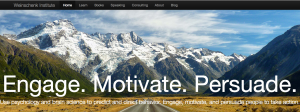Susan M. Weinschenk's Blog, page 36
October 14, 2013
New Series: 365 Ways To Persuade & Motivate
If you’ve been following my blog posts for a while you probably know that a few years ago I did a series called “100 Things You Need To About People”. It was a popular series that finished in April of 2011. Since then I’ve been writing individual blog posts, and wondering if I could/should come up with another series.
Well, I’m jumping in again, starting today. I’ve decided to do a new series called “365 Ways To Persuade & Motivate”. I’d like to do a blog a day for a year, but don’t hold me to that! I don’t know if I can really get a blog out every single day!
You can check out the first post of the series here.
Hope you enjoy the new series!
365 Ways To Persuade & Motivate: #1 Direct Eye Contact Is Not Always Best

We’ve all been told how important it is to make eye contact when interacting with other people. Direct eye contact makes you seem trustworthy, confident, and interested in the topic you are discussing, right? All those things are true BUT new research shows that direct eye contact can lessen the effectiveness of your message in one critical situation:
Frances Chen researched people listening and watching videos of other people talking about controversial social and/or political topics. Participants watched videos with speakers discussing topics with a strong viewpoint that was opposite to what the participants believed. Some participants were asked to watch the speaker’s eyes, and others were asked to watch the speaker’s mouth. Participants who watched the speaker’s eyes were LESS likely to change their opinion on the topic than the participants who watched the speaker’s mouth.
Why would this be true? Chen’s hypothesis is that direct eye contact can be seen as threatening.
Implications?:
If you are talking to people who agree with you, and trying to get them fired up to take action, then use direct eye contact.
But If you are talking to people who don’t agree with you, then you may want to minimize the amount of direct eye contact you have.
If you are making a video and you believe that people will agree with you, then look right into the camera lense.
If you are making a video and you think people don’t agree with you, then look off to the side instead of into the camera.
Here’s the research citation:
Chen, F.S., Minson, J.A., Schöne, M., & Heinrichs, M. (in press). In the eye of the beholder: Eye contact increases resistance to persuasion. Psychological Science.
September 19, 2013
New In-Person Courses
 There is something about September that makes us all want to sharpen our pencils and learn something new. And so we are very excited to announce the launch of 4 brand new in-person classes that we are offering in Chicago, San Francisco, St. Louis, Edgar WI, and Washington DC. I’m teaching some of them, but we also have some of the BEST and most experienced instructors teaching some as well.
There is something about September that makes us all want to sharpen our pencils and learn something new. And so we are very excited to announce the launch of 4 brand new in-person classes that we are offering in Chicago, San Francisco, St. Louis, Edgar WI, and Washington DC. I’m teaching some of them, but we also have some of the BEST and most experienced instructors teaching some as well.
One-day courses:
Don’t Guess: Test! The Why, What, and How of User Testing (Chicago, St. Louis, San Francisco, Washington DC)
How to Design Intuitive and Usable Products Through User Research (St. Louis, San Francisco, Washington DC)
The Science of Persuasive and Engaging Design (Chicago and San Francisco) (
3-day Workshop: Weinschenk Behavioral Science Workshop (Edgar, WI)
You can see a list of all the courses, dates, instructors, and locations at the Weinschenk Institute website, and link to detailed outlines.
To celebrate the course launch I’m writing a series of blog posts to highlight each course.
So here are 3 reasons why I’m excited about the Don’t Guess: Test! The Why, What, and How of User Testing course:
1) We’re partnering with UserTesting.com and they are going to provide us with FREE tests to use in the class, as well as giving every participant 3 FREE User Test Coupons to use after the class when you go back to your office to apply what you’ve learned.
2) With the free in-class test, you will conduct an actual user test during the course. You will decide what to test, who to test, write the test scenario and tasks, conduct the test, and watch the video.
3) Always wondered what to test? In this course you will learn how to write a usability specification and use that to guide you in deciding who to test, what to test, and what the success criteria should be. And you can use these usability specifications not only in user testing, but also in design.
The “Don’t Guess: Test!” course is intensive, hands-on interactive, and fun.
Text me at 847-909-5946 or send me an email at susan@theteamw.com by September 30, 2013, and I will give you a code to use during registration that will get you 25% off the course fee.
In the next post I’ll talk about the How to Design Intuitive and Usable Products Through User Research course.
September 9, 2013
Host a Class and Attend For Free
We’re launching in-person, one-day classes starting in December of 2013 (see class list below). If you are interested in hosting a class let us know.
Hosting means that you provide a meeting room (preferably one that holds 50 or more; ideally 100, but we can be flexible), screen projector, microphone, and wifi for all attendees. We take care of all the rest (registrations, course materials, etc). When you host you get 5 free seats to the class and a discount if you want to send any more people.
We are currently interested in finding hosts in these cities (including the general metropolitan area of each city):
San Francisco
Chicago
St. Louis
Indianapolis
Washington DC
Our first round of classes are: (Details and Registration coming soon)
The Science of Persuasive and Engaging Design
Don’t Guess: Test! The Why, What, and How of User Testing
How to Design Intuitive and Usable Products Through User Research
If you are interested in hosting please contact us: info@theteamw.com or call 847-909-5946
July 17, 2013
Red Or Blue?: Research On Screen Color That May Surprise You
 How does color affect our behavior when we are doing things online? Does it make a difference what the color background is? Does it depend on what we are reading or doing? Can you affect people’s decisions and behavior by changing the background color of a particular page or screen?
How does color affect our behavior when we are doing things online? Does it make a difference what the color background is? Does it depend on what we are reading or doing? Can you affect people’s decisions and behavior by changing the background color of a particular page or screen?
Research by Ravi Mehta and Rui Juliet Zhu from the Sauder School of Business at the University of British Columbia looks at these questions. In a fairly comprehensive set of different studies Mehta and Zhu found some interesting color effects. I describe the six studies below (but if you can’t wait for the punchline skip down to the “take-aways” section).
STUDY 1
In the first study people were first given anagrams to solve. Some of the anagrams used “avoidance” words, for example ‘prevent’, some of the words were “approach” words, for example ‘adventure’, and some were “neutral”, for example, ‘computer’. Sometimes the words were on a red background and sometimes on a blue background. People solved the avoidance words faster when they were on a red background (compared to blue or neutral) and they solved the approach words faster when they were on a blue background (compared to red or neutral).
The second task in this study had people read brand descriptions and then rate each brand on a scale from 1 to 7. Some of the brand descriptions had a message of a negative outcome you would want to avoid – for example a toothpaste that would prevent cavities. Others had messages of approach – for example a toothpaste that whitens your teeth. When the brands were on a blue background people preferred brands that were described with the approach or positive description. When the brands were on a red background people preferred the brands that had avoidance messages.
STUDY 2
In the second study people were given a “detailed” task — memorizing words. They were given 36 words to memorize in 2 minutes. Then they were asked to recall the words 20 minutes later. For some people the background screen was red, others blue and others neutral. People who did the task with the red screen remembered more words correctly than people with the blue or neutral background. People with the blue background would remember as many words as red, but several of the remembered words were actually false (i.e., they were not in the set of words originally memorized).
In the second part of study 2 people completed a “creative” task – they were asked to come up with as many creative uses for a brick as they could in 1 minute. A panel of judges rated how creative the list was. Some of the people worked on a red screen, others blue, and others neutral. The color didn’t affect how many ideas people came up with, but people working with a blue screen had more creative solutions than those in the red or neutral.
STUDY 3
In Study 3 people were asked to read sets of names or addresses which were either identical or were slightly different. It was a proofreading task. The participants had to decide whether one name and address matched another. Some people did the task on a blue screen, others on red and others on a neutral color. The participants were also asked afterwards whether they were focusing on avoiding mistakes or going quickly. People working with a red screen were more accurate on the task than people working on a blue or neutral screen. People working on a red screen also were more likely to report that they were trying to avoid mistakes.
STUDY 4
In Study 4 people were given a sheet of paper with drawings of different parts. They were asked to use any five parts and use them to design a toy that someone age 5 to 11 would play with. The parts were printed in either red or blue. Judges (using black and white copies of the design) then rated the designs based on originality and novelty (creativity) vs. practicality and appropriateness (attention to detail). Red toys were judged to be more practical and appropriate than blue. Blue toys were judged to be more original and novel.
STUDY 5
In study 5 people were shown ads for a camera on a computer screen. The ad was presented with a background color of either red or blue. In some versions of the ad there were pictures that showed product details of the camera, for example the lens. Other versions included visuals that were not about the camera, for example, a road sign, or a map, which would use creative thinking to connect the camera to a road trip. Participants rated the ads for their appeal and effectiveness. When the screen was red people rated the ad more highly when it included the specific product detail visuals. When the screen was blue then people rated the ad more favorably when the visuals were more conceptual.
STUDY 6
In study 6 people were given tasks in black font on a white background screen. They were told that one of the tasks required detailed and careful processing of information and that another would require creative, imaginative and “out of the box” thinking. They were asked to select which color, red or blue, they thought would enhance their performance on each task. People picked blue for BOTH tasks, i.e., they believed that blue would enhance their performance no matter what the task.
Here are my take-aways from this research:
If you are using a negative or fear message it will be more impactful if you use the color red. If you are using a positive message then use blue.
If you want people to do a detail-oriented task use a red background. If you want them to be creative use a blue background.
If you are highlighting detailed features of a product your message will be more persuasive if you use a red background. If you are highlighting concepts of how to use the product then the message will be more persuasive with a blue background.
People prefer blue backgrounds over red, even though red might make them get a task done more quickly. They are not aware of the effects that the colors are having.
IMPORTANT NOTE: These studies were all done in North America. There are cultural effects of color, so these results may NOT hold in different parts of the world.
What do you think? Are you willing to use red?
And if you like to read the research:
Ravi Mehta and Rui (Juliet) Zhu. Blue or Red? Exploring the Effect of Color on Cognitive Task Performances. Sauder School of Business, University of British Columbia, 2053 Main Mall, Vancouver, BC V6T 1Z2, Canada. www.sciencexpress.org / 5 February 2009 / Page 1 / 10.1126/science.1169144
July 16, 2013
New Online Video Course: How To Be A GREAT Presenter
I’ve just posted our latest online video course: How To Be A GREAT Presenter. It’s based on my book 100 Things Every Presenter Needs to Know About People. Here’s a little bit of information about the course:
Through July 31st, 2013 you can access the course for 50% off with this code: PresenterJuly. And if you aren’t ready to sign up, some of the lessons are available for viewing for free, so check it out!
June 21, 2013
New Blog and Website Design
You may have noticed that our blog page looks different than usual. That’s because we’ve switched to a new theme. You may or may not have noticed that the menu bar at the blog has also changed. The only link is to the Weinschenk Institute website. We’ve not only changed the blog, but we’ve launched a new website too. We’re in the middle of some user testing of the new site, and the blog, and we’re still iterating the design and the content. We’re up for comments if you have any feedback on either the blog or the website.
The new designs for both the blog and website are “responsive” designs with an emphasis on tablet and small footprint use.
Let us know what you think, either in the comments here, or send me an email: susan@theteamw.com
June 13, 2013
Is UX a “Rose by any other name?”
[image error]I’m going to be somewhat honest here: I’m no “spring chicken”. I don’t know if I’m prepared to tell you exactly how old I am, but here’s a story that will give you some hints: When I was in graduate school I had to file a formal appeal with the dean of the graduate school in order to get approval to create and submit my dissertation on a computer rather than typing on a typewriter. That hadn’t been done before and they weren’t sure it would be allowed (they did allow it).
Suffice it to say that I’ve had a long career in my “field”. But even after all this time I, and many others, are still struggling with what the field is, what it is called, and how to describe what we do. You’d think we’d have had it figured out by now, but we apparently haven’t.
So what is it that I do anyway? I use psychology and brain science to predict and direct behavior. A lot of my history has to do with designing the interactions between people and technology. Because I’ve been in the field so long I pre-date the term “user experience”. In fact, I pre-date many terms, including: usability, user friendly, user-centered design. The term I, and many others, tend to use most often is “user experience” but many object to the term “user”. And ask 10 “user experience professionals” what they do and they will tell you 10 different things.
Jim Jacoby has a post at the admci website with a great video of Peter Merholz speaking at a conference about what user experience really is, and what the work really is. I don’t agree with everything Peter says, but it is a thought-provoking video, and it got me thinking not only what user experience people do, but about the term “user experience”.
I’d like to use a different term to describe what I do, but I’m not sure what that would be.
Customer experience doesn’t work because a lot of the experiences I am designing aren’t for customers. They might be for employees, or visitors. Is a museum visitor really a “customer”? I know the employees at Wal-Mart aren’t “customers”. And people going to their government website to do self-service are not really customers either. I’ve designed for all of these audiences, so “customer” doesn’t really work.
Then I thought perhaps I’d just describe it as “Experience Design” or “Behavioral Design”. But that brings us into the thorny area of what “design” means. Is it visual design? Interaction design? And sometimes I’m not even designing. I’m evaluating, or strategizing what the experience should or should not be. But the terms “Experience Strategy” or “Behavorial Strategy” seem just as bad as “User Experience”.
A rose by any other name is still a rose?
What do you think? How do you describe and name it?
June 4, 2013
What’s The Best Way To Train User Experience Professionals?
[image error]
What’s the best way to get knowledge and skills to be a user experience professional? Can you learn it all on the job? Is there a role for education and classes? If there is, what kind of classes?
Should you try and get a college degree? (There are very few undergraduate schools, that actually have a degree in user experience. Some have some classes, and maybe a concentration, but few have a degree. Should you get an undergraduate degree in something else — anything related — and then get a master’s in HCI (Human-Computer Interaction).
What about short courses? Should you take a week or two of training from a vendor? Or take some online training classes?
I’ve been thinking about this question for many years. I’ve offered “industry training” (i.e., a week-long class), and I’ve offered mentoring programs. I recently taught a semester long class as an Adjunct Professor at University of Wisconsin. And the Weinschenk Institute has online video courses you can take to learn about user experience and user-centered-design topics.
So when my colleague Jim Jacoby (founder of Manifest Digital in Chicago) told me the other day that his new venture was The School for Digital Craftsmanship, I asked him to tell me more. And then after he told me about the user experience/user-centered design “school” he has started, I suggested we do a podcast interview about it.
Below you will find the 23 minute podcast interview.
You can listen to the podcast by clicking on this link
Here are some of the topics we cover:
How a shortage of user experience/user-centered design professionals in his agency led him to start the School for Digital Craftsmanship
The idea of a “trade” school education for the field, that combines classroom study with practical experience
The first flagship courses that start this July (2013). They are 10 weeks long and meet a few nights a week, starting in Chicago and St. Louis.
What the application process is like, and what the experience will be like to attend.
As of this writing there are 12 spots still open for the classes starting in July, so if you are interested go to the School’s website: admci.org for more information.
What do you think? What’s the best way for people to get the education they need to do UX/UCD work?
May 29, 2013
5 Favorite Tips From Famous UX Experts
[image error]I attended and spoke at the Virtual conference from Rosenfeld Media today “31 Awesomely Practical UX Tips”. Each speaker presented their favorite user experience tips. I took one tip from each of the speakers as my favorite. Here they are:
Steve Krug — Test your competition/comparables. Before you choose a design path or design idea, find someone else who is doing it and run a user test of their site/app/product. That way you can see what works and what doesn’t before you even start your design.
Whitney Quesenbery — Many of the best designs we all use started out as products designed for accessibility, for example, rolling mail carts for postal delivery people (started off being used by women since it wasn’t believed they could carry a heavy load) and Good Grips tools from OXO (started as special tools for people with arthritis, but now they are just known as well-designed tools).
Jeffrey Eisenberg — Instead of designing to fit your selling process and selling cycle, design instead to fit the customer’s BUYING process and buying cycle. These are not the same thing.
Aaron Walter — Stop designing in Photoshop. Use something like Bootstrap where you can see what things really look like and you can concentrate on the “system” not the “page”.
Luke Wroblewski — 75% of people using smartphone apps are using one thumb — Have you designed for one thumb use?
It was a GREAT day of learning. It was hard to just pick one from each!




